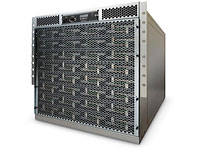Can news be both surprising and unsurprising?
Let’s start with the unsurprising part of the announcement that AMD is acquiring SeaMicro, which is that the startup has been taken off the market for a cool $334 million. Since it unstealthed in June 2010, the company has attracted customers like Google and Mozilla with a dense, cloud-friendly server architecture packed with up to 512 low-power, Atom processors.
This setup allows companies to deliver Web services while taking up less rack space and lowering power and cooling costs — important considerations as cloud providers build and outfit massive new data centers to meet demand.
Since its debut, it “up-scaled” its interconnect fabric to accommodate Xeons. Though not as low-watt as Atoms, SeaMicro systems based on Xeon server chips can still leverage many of the energy-saving and performance-enhancing benefits of the architecture for traditional, enterprise-grade workloads like databases, OLTP and the sort.
Intel’s Opportunity to Squander
Frankly, it’s not even all that surprising that the deal turns AMD into a vendor of servers based on its rival’s chips, at least in the short term. Nope, what’s really shocking is that Intel practically rolled out the red carpet for AMD and let it walk away with SeaMicro’s tech.
SeaMicro and Intel enjoyed a cozy relationship. Each SeaMicro system requires up to 384 Atoms or 64 Xeons. Sure, SeaMicro isn’t pushing as much product as say HP or Dell, but they’re still not amounts to sneeze at.
Well, Intel seemed downright allergic to the SeaMicro’s approach in 2010 a few short months after it emerged from stealth. Back then, the company viewed Atom-based servers as too niche to pursue. In fairness, it holds true, even to this day.
But AMD isn’t paying a third of a billion dollars for SeaMicro’s knack of getting netbook processors to power Web services — and mind you, AMD is not exactly raking in the dough lately. Rather, the company is buying an architecture that makes it possible for low-power, consumer-grade chips — and now full-fledged server processors like the Xeon — to handle huge workloads, fast and in an energy-efficient and space-saving manner.
As cloud providers as build out their infrastructures in these cost- and energy-conscious times, it’s a message that resonates a little more loudly. All that’s left is for AMD to deliver on it.
Image credit: SeaMicro


Leave a Reply